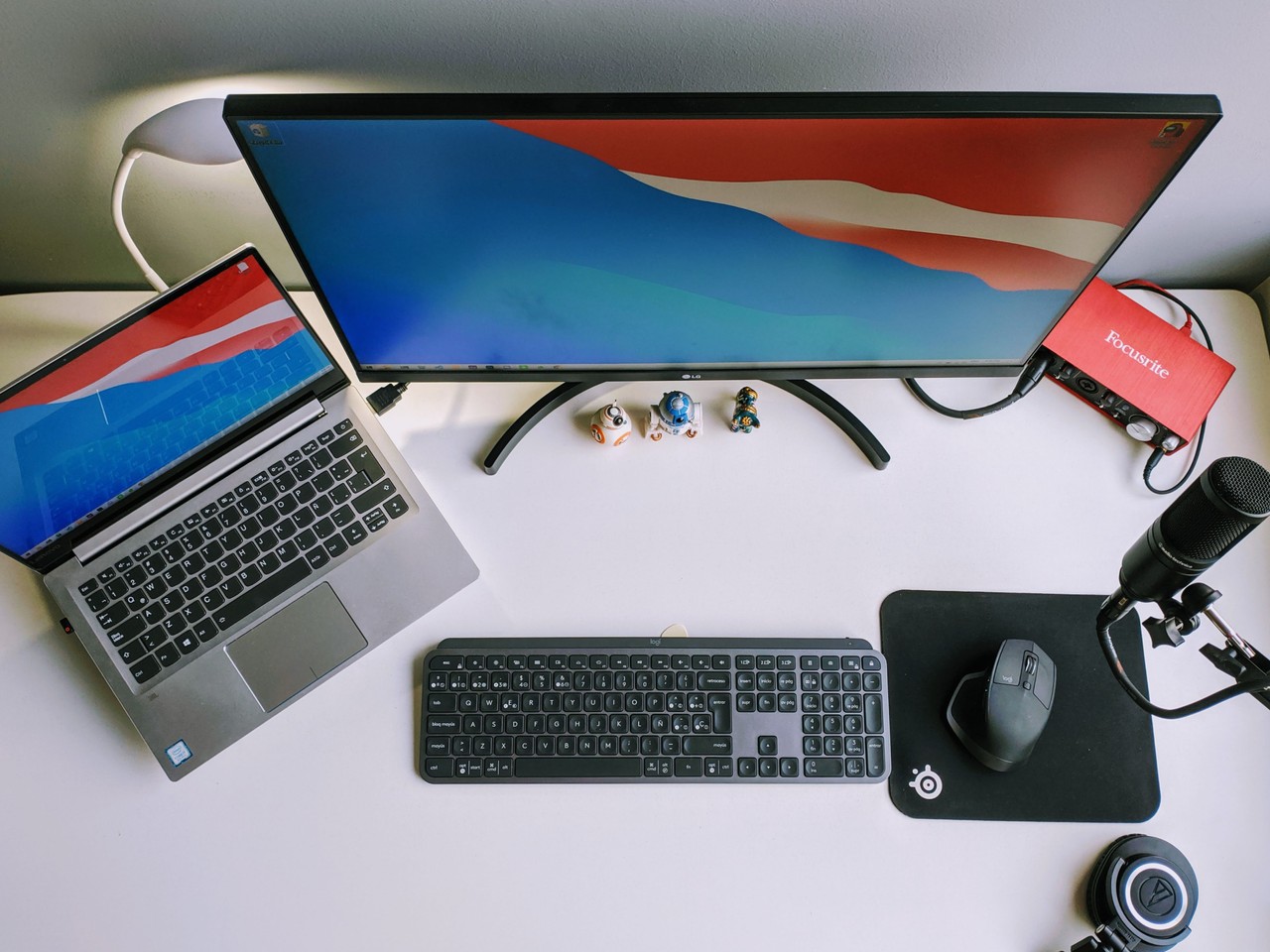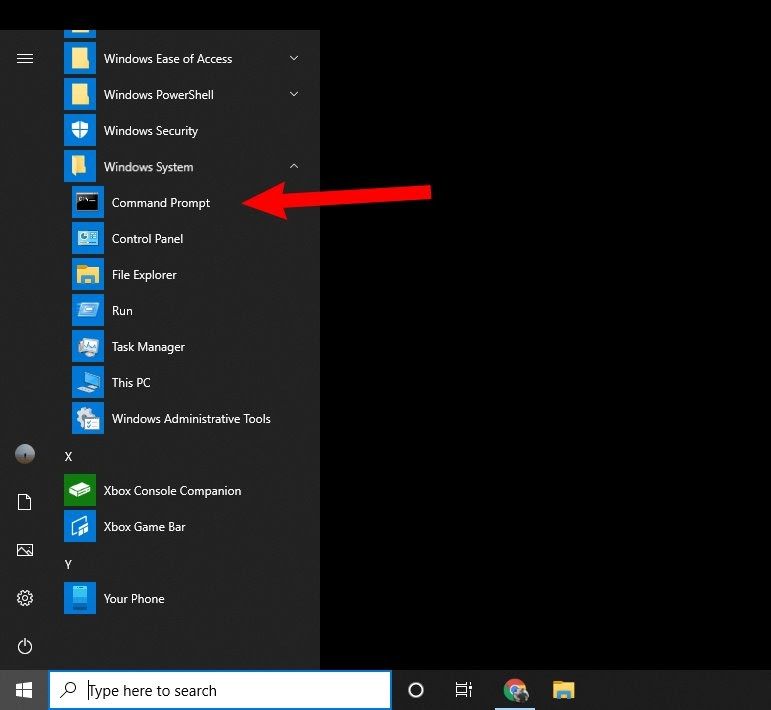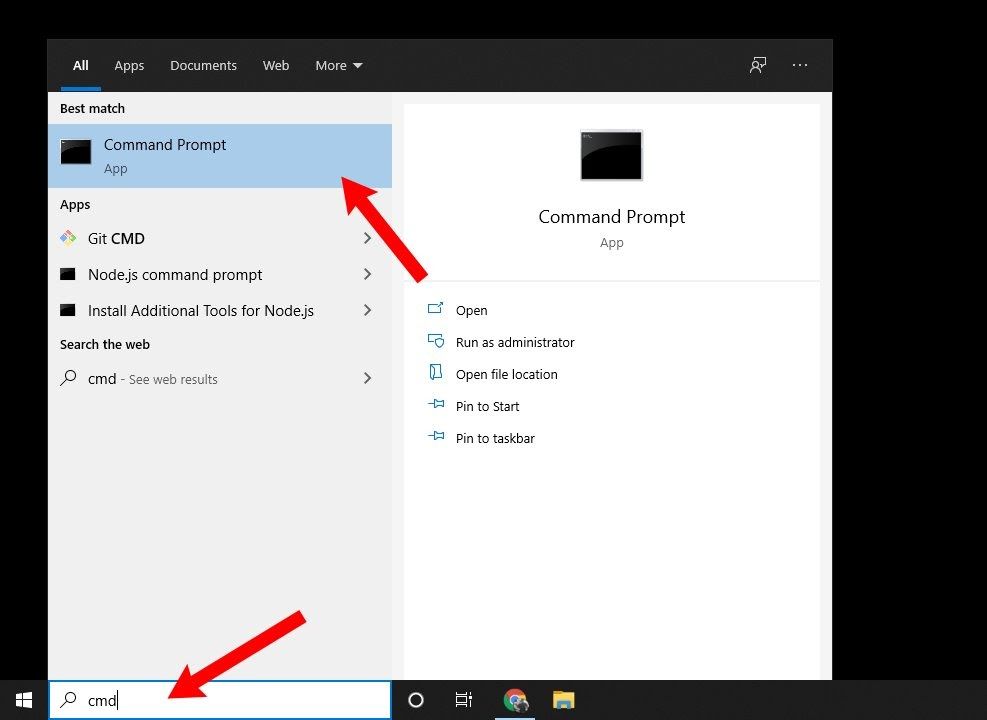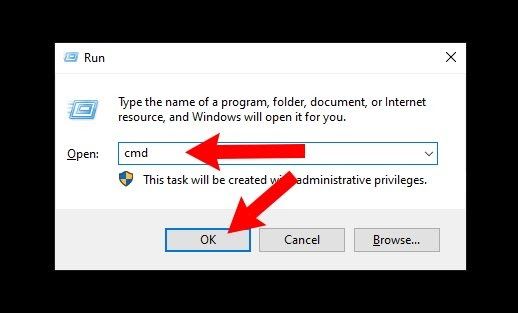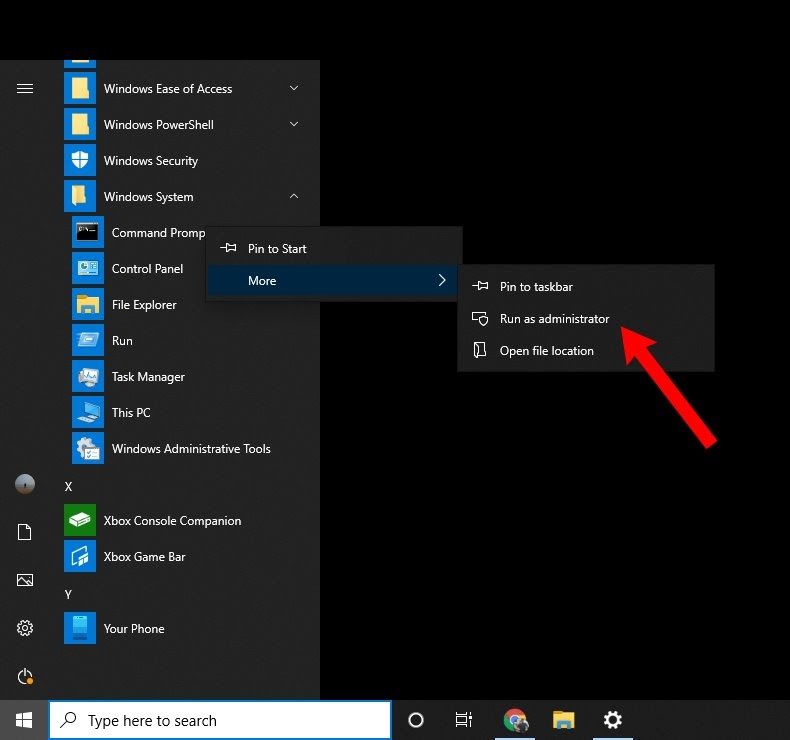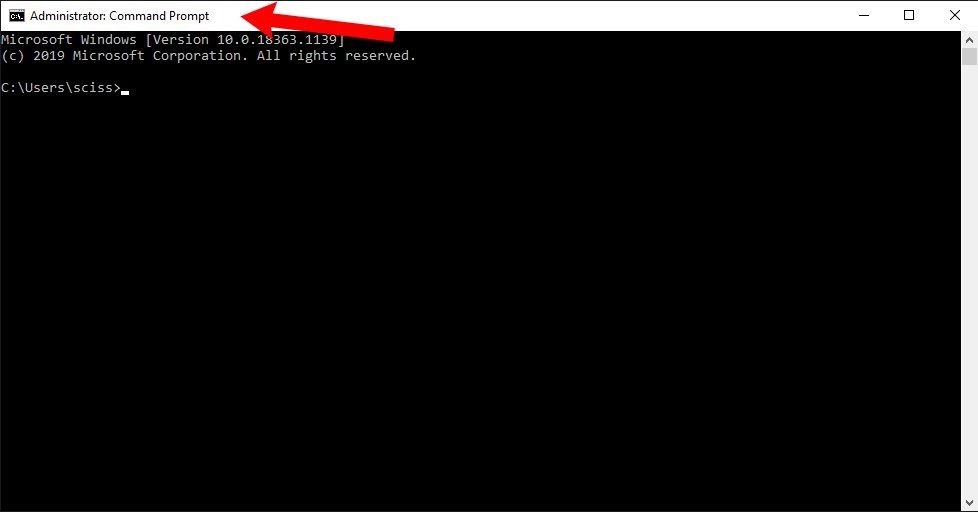Download Article
A quick guide to accessing the Windows command prompt (CMD)
Download Article
- Searching for Command Prompt
- Using the Run Program
- Navigating to Command Prompt
- Using the File Explorer
- Running as Administrator
- Video
- Q&A
- Tips
- Warnings
|
|
|
|
|
|
|
|
The command prompt can be used to execute specific commands and perform advanced functions. If you need to troubleshoot your Windows laptop or computer, you may need to run the command prompt. Luckily, you can launch CMD using a variety of easy methods. You must have administrator access to run the command prompt, so you won’t be able to do this on school computers or other locked devices. This wikiHow will show you how to get to and open the command prompt (CMD) on your Windows 8, 10, or 11 computer.
Things You Should Know
- Open the «Start» menu and type «cmd». Click «Command Prompt».
- Press «Windows» + «R» to open the Run program. Type «cmd» and press «Enter».
- Open the «Start» menu. Click «Windows System» folder to expand it. Click «Command Prompt».
-
1
Open Start
. Click the Windows logo in the bottom-left corner of the screen, or press the Windows key. You can search for Command Prompt on all supported versions of Windows, such as Windows 8, Windows 10, and Windows 11.[1]
- If you’re using Windows 8, place your mouse cursor in the top-right corner of the screen, then click the magnifying glass icon when it appears.
-
2
Type cmd or command prompt into the Start menu. Typing into the Start menu will automatically begin a search.
Advertisement
-
3
Click
Command Prompt. You should see the Command Prompt icon appear near the top of the Start window. Clicking its icon will open the Command Prompt.
Advertisement
-
1
Open the Run program. On your keyboard, press the Windows key + R at the same time. The Run window will open.
- Alternatively, you can right-click the Start icon (or press Windows + X) and click Run.
-
2
Type cmd into Run. This is the command to open Command Prompt.
-
3
Click OK or press ↵ Enter. This will run the «cmd.exe» command, which opens Command Prompt.
- You’ll now be able to use CMD.
Advertisement
-
1
Open the Start
menu. Click the Windows logo in the bottom-left corner of the screen. You can also press the Windows key.
- On Windows 11, this can be found at the bottom center of the screen.
-
2
Scroll down to Windows System and click it. This folder will be near the bottom of the Start window.
- On Windows 11, click All apps, then Windows Tools.
-
3
Click
Command Prompt. It should be near the top of the Windows System folder. This will open Command Prompt.
- On Windows 11, this will be at the top of the Windows Tools folder.
- If you’re unable to open the Command Prompt, you may need to open as an admin.
Advertisement
-
1
Open the File Explorer. Click the Start menu and type in «file explorer». Click File Explorer to open it.
- If you have the shortcut pinned to your taskbar, right-click the icon and click File Explorer to open a new window.
-
2
Click the address bar. This will be near the top of the window.
- You might see Quick access in the address bar by default.
-
3
Type cmd and press ↵ Enter. This will replace any text in the address bar with your new path.
- The Command Prompt will open.
Advertisement
-
1
Locate the Command Prompt. Click the Start menu and type cmd. The search result will appear in the menu.
-
2
Right-click the Command Prompt. A pop-up menu will open.
-
3
Click Run as administrator. You can now use the Command Prompt as an administrator, which gives you access to more permissions and commands.
Advertisement
Add New Question
-
Question
How do I close out Command Prompt?
ClixTech Australia
Community Answer
Type «exit» in the Command Prompt, or press the red «X» in the top right corner, or press Alt+F4 on the keyboard. Check out the Close Command Prompt article for more detailed instructions!
-
Question
What do I do if I can’t use Microsoft Edge and the Start button?
Press the Windows Key + R, then type in cmd.exe and hit enter.
-
Question
How do I stop Windows command prompt from starting up automatically?
If it starts up every time, then something is causing it. It may be a program or a shortcut to command prompt that is saved in your Windows start folder. If you want to stop it from appearing altogether by uninstalling it, you won’t be able to.
See more answers
Ask a Question
200 characters left
Include your email address to get a message when this question is answered.
Submit
Advertisement
Video
-
Command Prompt is a good place to run legacy or specialty software. You might also use it if you’re trying to manipulate specific files.
Advertisement
-
If you’re using a computer with restricted access to settings and programs, you may not be able to open Command Prompt.
Advertisement
About This Article
Article SummaryX
1. Open Start.
2. Type in command prompt.
3. Click Command Prompt at the top.
Did this summary help you?
Thanks to all authors for creating a page that has been read 610,206 times.
Is this article up to date?
Search the Start menu for CMD or Command Prompt
What to Know
- Search the Start menu for Command Prompt.
- Alternatively, in Windows 11/10, right-click the Start button and select Terminal or Command Prompt.
- Another method that works in all Windows versions is to execute the cmd command from the Run dialog box.
This article explains how to open Command Prompt, which is one of the command-line interface programs used to execute commands in Windows operating systems. Command Prompt can really come in handy now and then, maybe to troubleshoot a specific Windows problem or to automate certain tasks.
Open Command Prompt in Windows 11 or 10
There are a few ways, but using the search bar on the taskbar is one quick method.
-
Select the Start Menu (the Windows icon) in the taskbar, or press the Windows key.
-
Type cmd.
-
Select Command Prompt from the list.
If you’re using the latest version of Windows 11, Command Prompt will open within Terminal.
Open Command Prompt Through the Start Menu Folder
Another way to open Command Prompt in Windows 10 is to look in its Start menu folder:
-
Select the Start Menu (the Windows icon) in the taskbar, or press the Windows key.
-
Select the Windows System folder from the list.
-
Choose Command Prompt from the folder group.
Open Command Prompt Using Power User Menu
One more method is through the Power User Menu. If you’re using a keyboard or mouse, choose Terminal (Windows 11) or Command Prompt (Windows 10) from the menu that appears after pressing Win+X or right-clicking the Start Menu.
You might see PowerShell options in the Power User Menu instead of Command Prompt. In more recent versions of Windows 10, Command Prompt has been replaced by PowerShell, but you can switch between PowerShell and Command Prompt from the Power User Menu. Terminal is the replacement in Windows 11.
Open Command Prompt in Windows 8 or 8.1
You’ll find Command Prompt in Windows 8 through the Apps screen.
-
Select the Windows Start button and then swipe up to show the Apps screen. You can accomplish the same thing with a mouse by selecting the down arrow icon at the bottom of the screen.
If you’re using a keyboard or mouse, a really quick way to open a Command Prompt window in Windows 8 is through the Power User Menu—just hold the WIN and X keys down together, or right-click the Start button, and choose Command Prompt.
Prior to the Windows 8.1 update, the Apps screen can be accessed from the Start screen by swiping up from the bottom of the screen, or right-clicking anywhere, and then choosing All apps.
-
Swipe or scroll to the right on the Apps screen to locate the Windows System section heading.
-
Select Command Prompt. You can now execute whatever command you needed to run.
Open Command Prompt in Windows 7, Vista, or XP
In these versions of Windows, Command Prompt is found through a folder group in the Start menu.
-
Open the Start Menu in the bottom-left corner of the screen.
In Windows 7 and Windows Vista, it’s a bit faster to enter command in the search box at the bottom of the Start menu and then choose Command Prompt when it appears in the results.
-
Go to All Programs > Accessories.
-
Choose Command Prompt from the list of programs.
Other Ways to Open Command Prompt
Command Prompt in Windows 11 through Windows XP can also be opened with a command. This is especially helpful if you like using the Run dialog box or if File Explorer has crashed and the Start menu is inaccessible (and thus the directions above don’t work).
To do this, enter cmd into the command-line interface. This can be in the Run dialog box (WIN+R) or Task Manager’s Run new task option (go to File > Run new task if you’re not using Windows 11).
Elevated Command Prompts and Old Windows Versions
In versions of Windows released before Windows XP, like Windows 98 and Windows 95, Command Prompt doesn’t exist. However, the older and very similar MS-DOS Prompt does. This program is located in the Start menu and can be opened with the command run command.
Some commands, like the sfc command that’s used to repair Windows files, require that Command Prompt be opened as an administrator before they can be executed. You’ll know if this is the case if you get a message like one of these after trying to execute the command:
- check that you have administrative rights
- … command can only be executed from an elevated command prompt
- you must be an administrator
FAQ
-
How do you change directory in Command Prompt?
Type the command cd followed by a space and the name of the folder. For example, assuming you’re currently in the Users folder and want to change to the Documents folder, the command is cd Documents. You can also type in cd and drag and drop the folder you want to switch to into Command Prompt.
-
How do you open a command prompt on Mac?
Instead of Command Prompt, Mac owners use a program called Terminal. To open it, select the Launchpad icon in the Dock and type Terminal in the search field, then select the app. Alternatively, go into Finder and open the /Applications/Utilities folder to find it.
-
How do you copy/paste into Command Prompt?
You can use the same keyboard shortcuts you use to copy/paste in other programs—CTRL+C and CTRL+V. On Mac, copy the text in another app, then go into Terminal and choose Edit > Paste.
-
How do you open Command Prompt in a folder?
Go into the folder and Shift+Right-Click, then select Open PowerShell window here, or Open in Terminal, to open Command Prompt in a folder. On Mac, right-click the folder and select New Terminal at Folder from the menu.
-
How do you navigate Command Prompt?
Use the cd command to change directories in Command Prompt. To access another drive, type the drive letter followed by a : (C:, D:, etc.). View the contents of a folder using the dir command.
Thanks for letting us know!
Get the Latest Tech News Delivered Every Day
Subscribe
Загрузить PDF
Загрузить PDF
Открыть командную строку в ОС Windows довольно легко. Представленная статья покажет вам, как это сделать.
-
1
Щелкните по кнопке «Пуск» (Start) в левом нижнем углу экрана.
-
2
Выберите из списка опцию «Выполнить…» (Run…).
-
3
Введите «cmd» в диалоговом окне опции «Выполнить…» (Run…).
-
4
Нажмите клавишу [Ввод/Enter].
Реклама
-
1
Кликните по кнопке «Windows» в левом нижнем углу экрана.
-
2
Начните ввод «cmd» в поле «Приступить к поиску» (Start search) внизу экрана рядом с кнопкой.
-
3
Нажмите на «cmd» под разделом «Программы» (Programs).
-
4
Если то, что вы пытаетесь сделать, не срабатывает, тогда попробуйте щелкнуть правой кнопкой мыши по «cmd» и кликнуть «Запустить от имени администратора» (Run as administrator).
Реклама
-
1
Нажмите на кнопку «Windows» в левом нижнем углу вашего экрана.
-
2
Начните ввод «notepad» в поле «Приступить к поиску» (Start search) внизу экрана рядом с кнопкой.
-
3
Нажмите на «notepad» под разделом «Программы» (Programs).
-
4
Напечатайте «comd» в вашем новом документе.
-
5
Сохраните его как «prompt.bat» на своем рабочем столе.
-
6
Дважды щелкните по файлу на рабочем столе*
Реклама
Помимо доступа к командной строке из меню «Пуск» (Start) вы можете также выполнить следующую цепочку действий: щелкните «Пуск» (Start) > «Все программы» (All Programs) > «Стандартные» (Accessories), а затем выберите пункт «Командная строка» (Command Prompt) в меню «Стандартные» (Accessories).
В командной строке вы имеете возможность запускать команды для отображения директорий:
dir (отображаются все файлы и каталоги в текущей директории)
dir myfolder (отображаются все файлы и папки в папке «MyFolder»)
dir *.zip (показываются все файлы с расширением .zip)
Вы также можете вывести список файлов в системе, используя следующие команды:
cd
dir /s (отображаются все файлы и папки на текущем диске)
dir /s *.zip (выводится на экран список всех zip файлов на текущем диске)
Для получения дополнительной информации об инструментах и других видах программного обеспечения посетите сайт http://www.agnitech.com. Мы также предлагаем программное обеспечение для ресторанов, салонов, ювелирных магазинов, точек продажи и оптовых поставок.
Предупреждения
- Пожалуйста, не делайте ничего вредоносного для ПК в командной строке.
Реклама
Об этой статье
Эту страницу просматривали 12 716 раз.
Была ли эта статья полезной?
If you need to run commands like mkdir, ping, and netstat in Windows, you’ll need to open the Command Prompt program.
Turns out that there are a bunch of ways to do that. We’ll cover some of the most common ways to open Command Prompt in this article.
Note: While this article was written for Windows 10, some methods should be similar for earlier versions of Windows.
How to open Command Prompt from the Windows Start Menu
First, click the Start Menu button in the lower-left corner to open the start menu.
Scroll down to “Windows System” and click that to open a dropdown of different Windows programs. Then click “Command Prompt”:
How to open Command Prompt with the search bar
One of the fastest ways to open Command Prompt is by using the search bar in the Windows 10 Taskbar.
Just type “cmd” into the search bar and click on “Command Prompt”:
How to open Command Prompt from the Run program
Windows 10 has another program called Run that lets you, well, run other programs. You can also do things like open folders and files, but that’s outside the scope of this tutorial.
To open Run, you can open the Start Menu and find it under “Windows System”. You could also type “run” in the search box and find it that way.
But the fastest way to open Run is with the shortcut Windows Key + R.
Then, once the Run window is open, just type in “cmd” and press “OK” to open Command Prompt:
How to open Command Prompt as an administrator
Some commands like powercfg or chkdsk require that you open Command Prompt as an administrator. This will give you elevated access for whatever commands you run.
To open Command Prompt as an administrator, find Command Prompt using any of the methods described earlier.
Then, right click on “Command Prompt” and click “Run as administrator”:
You may need to hover over “More” depending on the method you used to find the Command Prompt program.
Also, you may see a “User Account Control” window pop up with the message “Do you want to allow this app to make changes to your device?” Just click “Yes” to continue.
After this, you should see a Command Prompt window with “Administrator: Command Prompt” across the top:
Alternatively, you could open Command Prompt as a normal user, type in a command, and then press Ctrl + Shift + Enter to run that command as an administrator.
Note: While you should always be careful about what commands you run in Command Prompt or any other command line program, be especially mindful about what you run as an administrator. One wrong command could delete important system files and ruin your installation of Windows.
In summary
These are just some of the many ways to open Command Prompt in Windows. Go with whatever works best for you and run commands to your heart’s content.
But please, before you run any command, double check that everything is correct, especially if you opened Command Prompt as an administrator. Speaking from experience, a few extra seconds of caution could save you hours of reinstallation.
And with that, go forth and (safely) run all the commands.
Learn to code for free. freeCodeCamp’s open source curriculum has helped more than 40,000 people get jobs as developers. Get started
If you’ve been a Windows user for a while now, we’re sure you would’ve fumbled your way into the Command Prompt at least once. The Command Prompt is a command-line interface application used to execute all the commands from a single place.
In fact, it’s this very option to control major aspects of execution and troubleshooting, which makes using Command Prompt a hugely popular tool among Windows power users. But did you know that there’s more than a single way to open the Command Prompt?
In this article, we’ve taken care of that by covering all the different methods to open the Command Prompt. Let’s begin with the simplest one first.
1. Open the Command Prompt via the Start Menu
The Start menu was first introduced with Windows 95 in 1995. Since then, it has been used as a central hub for listing all the important programs, files, and folders of your Windows computer.
Naturally, you can also use it to access the Command Prompt. To get started, go to the Start menu search bar, type in ‘command prompt,’ and select the Best match.
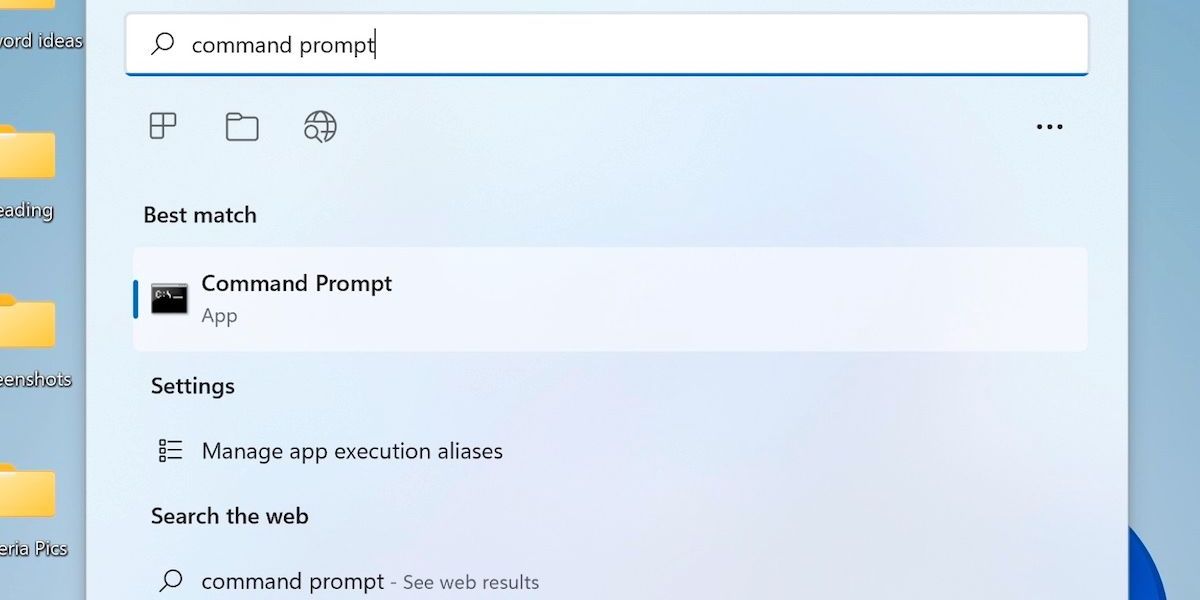
The Command Prompt will be launched, and you can now execute different commands to your liking.
However, note that for executing some commands you’ll need to have special privileges, and for that, you will have to launch the Command Prompt in the ‘elevated’ mode. The elevated mode, or the administrative account as it’s sometimes called, is nothing but a way to access a program as a ‘superuser,’ letting you take actions that might otherwise be restricted for a normal account.
To open the Command Prompt in an elevated mode, right-click on the Command Prompt icon from above and run it as Administrator.
2. Use the Run Dialog Box
The Run dialog box is a simple program that makes it super easy to access other programs, files, and folders through a simple command. Moreover, it can only be accessed with a keyboard and for this reason, it can come super handy when your mouse or GUI is giving you a hard time.
To access the Command Prompt through the Run dialog, follow the steps below:
- Press Win + X to open the Run dialog box.
- Type in ‘cmd’ in the dialog box and hit OK.
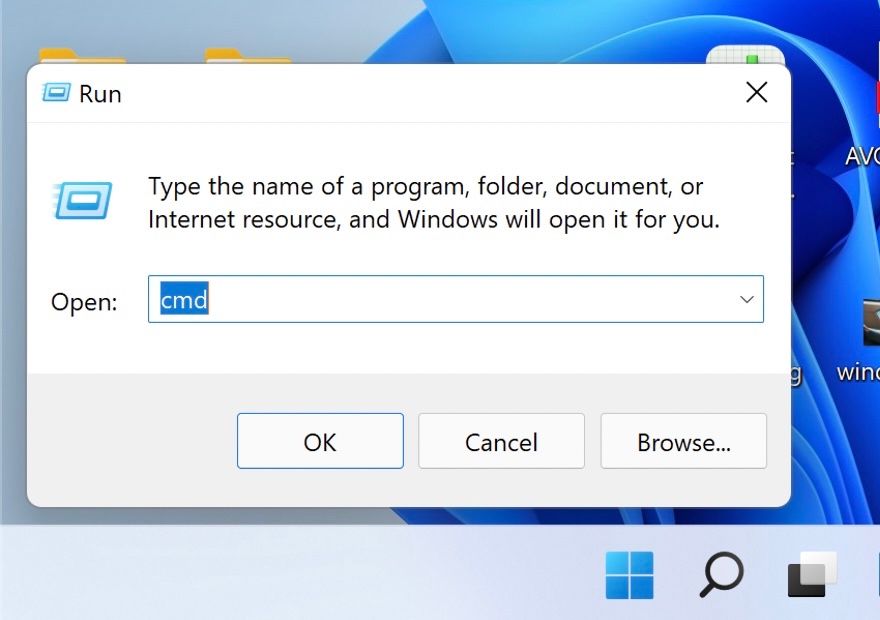
Complete the steps above, and the Command Prompt will launch.
3. How to Use the Task Manager to Open the Command Prompt
The Task Manager is a crucial Windows program, designed to give general information about the applications running on your computer. Interestingly, it can also be used to open different applications. In our case, this means you can also use it for running Command Prompt.
To get started, go to the Start menu search bar, and select Task Manager. Alternatively, press Ctrl + Alt + Delete key together, and the Task Manager will be launched.
After the Task Manager is open, follow the steps below:
- Click on File > Run new task.
- Once the dialog box pops up, type in ‘cmd,’ and click on OK.
- If you want to launch the Command Prompt with administrative privileges, then check the “Create this task with administrative privileges,” and select OK.
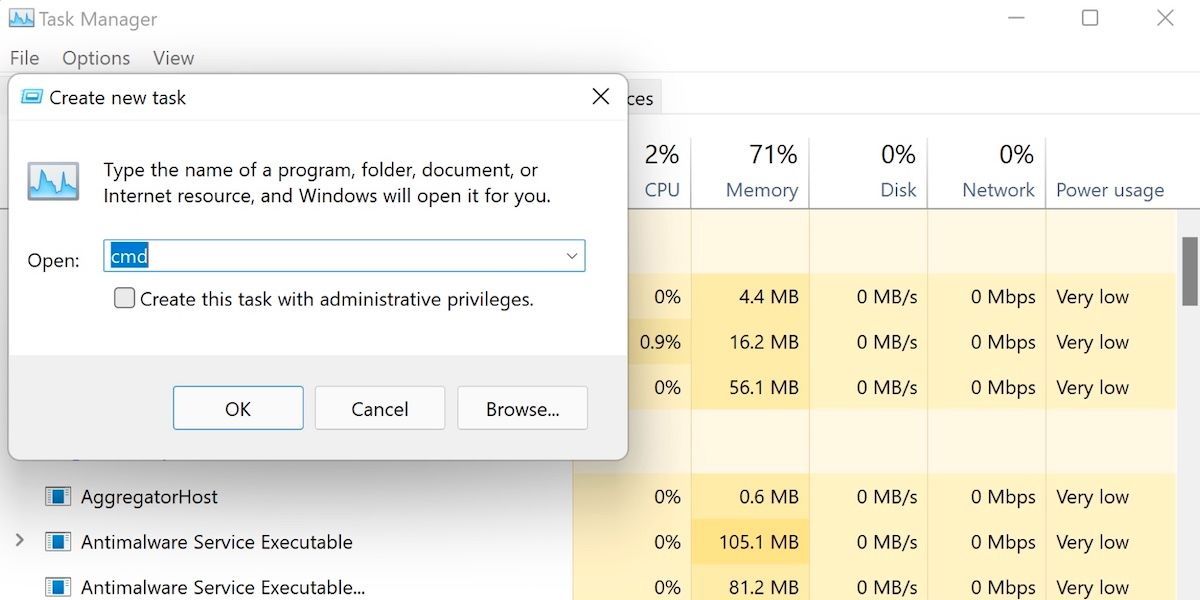
And that’s how you can utilize the Task Manager with Windows 11. Make no mistake, though, as this is only the tip of the iceberg; Task Manager is a powerful app, and can help you do far more interesting and powerful things than what we’ve covered here.
4. Open the Command Prompt With a Desktop Shortcut
A desktop shortcut is a handy alternative for accessing your programs, especially if you have to use an application again and again. All you have to do is create a simple desktop shortcut of Command Prompt, and you’ll be set for accessing Command Prompt easily through your desktop.
To get started, right-click on the Desktop item, navigate to the New item, and select the Shortcut option.
A dialog box called ‘Create Shortcut’ will pop open. There, type ‘cmd’ and click on Next.
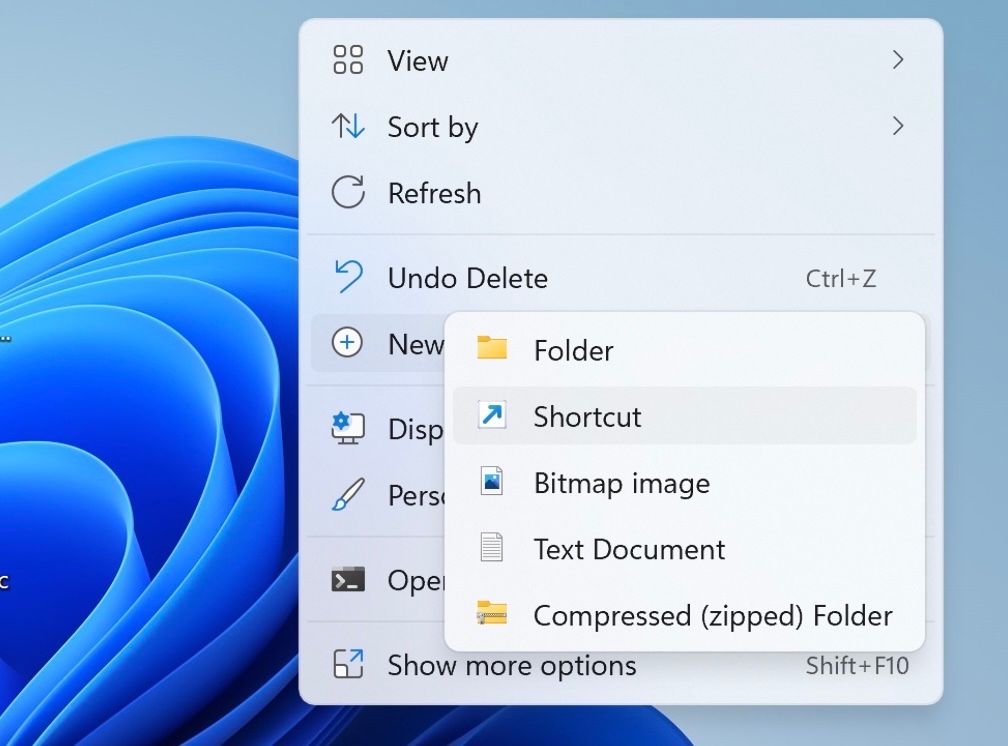
Now give a suitable name to the Command Prompt shortcut and click on Finish. This will create a working Command Prompt shortcut for your PC.
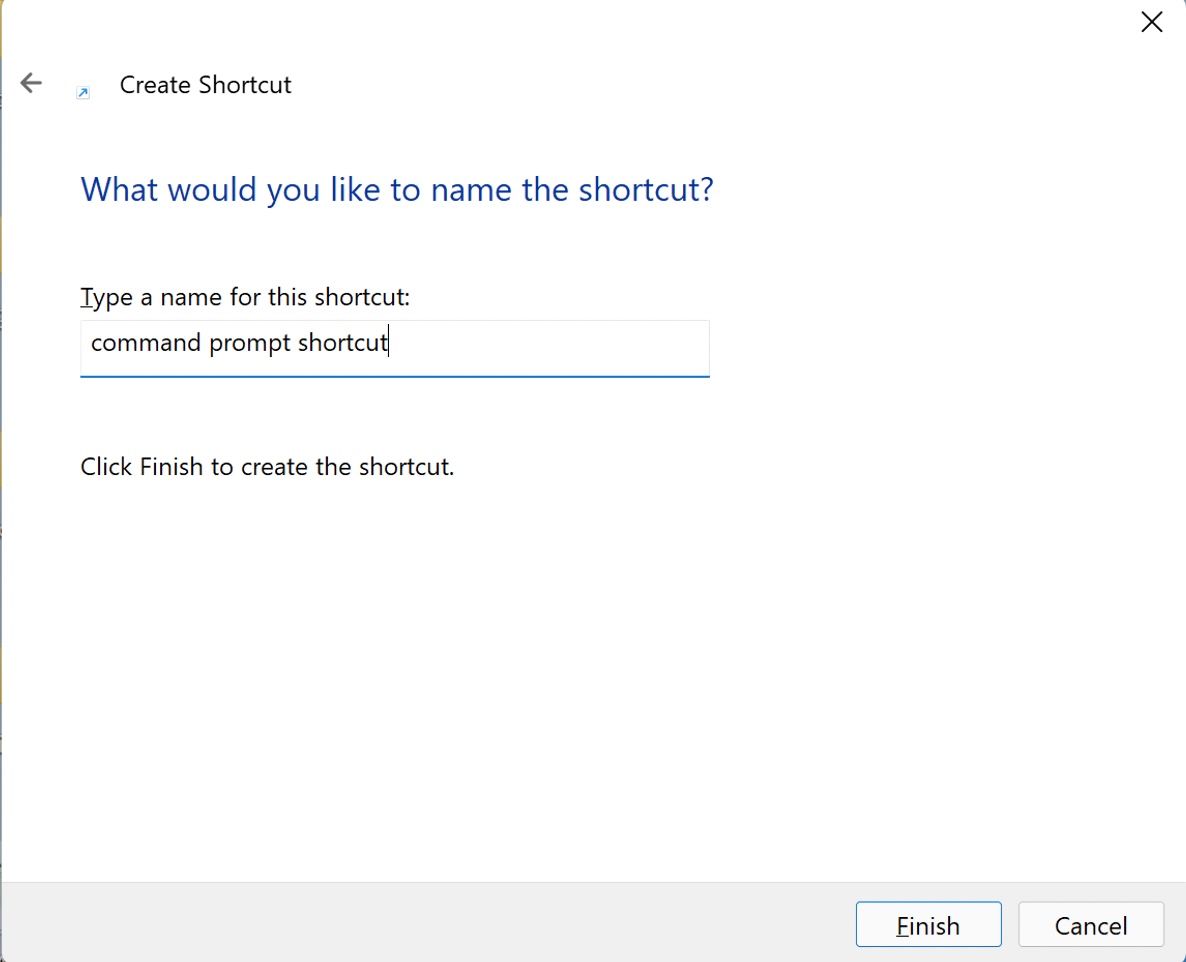
Whenever you have to launch the Command Prompt, simply click on the shortcut. Again, if you’d like to launch the Command Prompt with administrative privileges, right-click on the Command Prompt and select the Run as administrator option.
5. Use File Explorer to Open the Command Prompt
If you’re unsure as to what File Explorer is, there’s an extremely good chance you’ve already used it. Every time you open a folder or browse your PC’s files through Windows, you’ve done so through File Explorer. More formally, File Explorer is a file manager application that lets you access your Windows files and folders easily.
To access the Command Prompt from the File Explorer, all you have to do is use the address bar of File Explorer. To do this, open This PC, go to the address bar, and type in ‘cmd.’ Hit Enter.
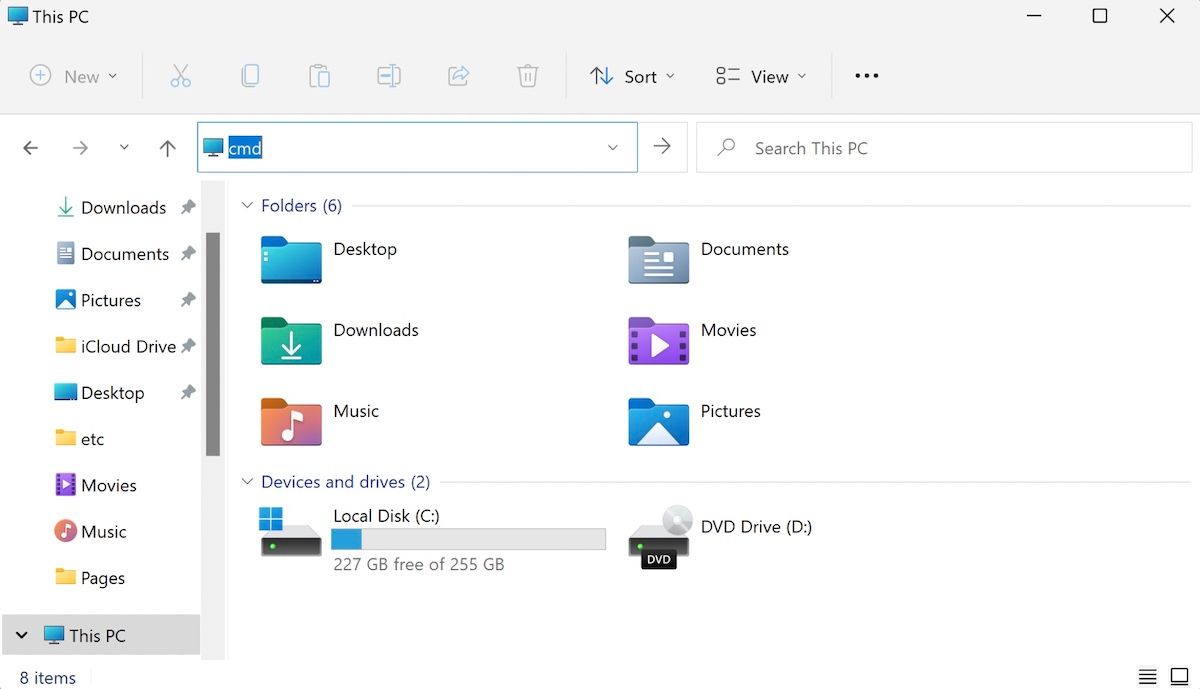
As soon as you do this, the Command Prompt will be launched.
Alternatively, you can also access the Command Prompt by entering the file location of the cmd.exe file. Go to the top of the address bar and enter the following path in the address bar, and hit Enter.
C:WindowsSystem32
This will launch the System 32 folder, which contains numerous system executables and libraries. Once you’re in, locate and double-click on the cmd.exe file to launch the Command Prompt.
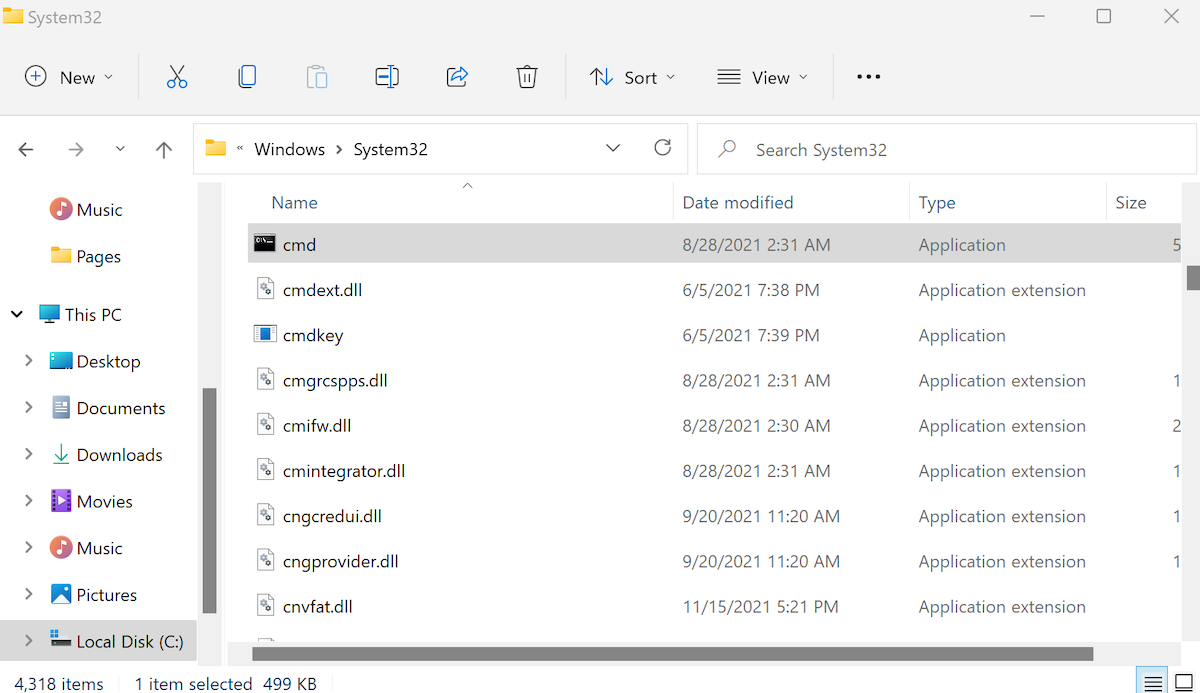
If you want to open the Command Prompt with administrative privileges, though, right-click on the cmd.exe file and click on Show more options from the context menu. With the complete list of options in front of you, now click on Run as administrator. This will launch the Command Prompt in elevated mode.
Launching the Command Prompt in Windows 11
And that’s all about Command Prompt, folks. Fundamentally a command-line interpreter, the Command Prompt is a great way to manage your system administration all from a single place. Although my personal favorite is the Start menu method because of how straightforward it is, we felt strongly about laying out all the different approaches at our disposal. So, if either of these methods fails, you now have multiple ways around it.

































